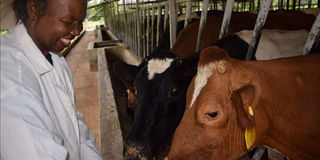A sweet retirement deal with dairy cows

Alice Gondi, Managing Director Ayika Farm attending to her dairy herd in Kisumu. The farmer has 28 dairy cows. PHOTO| ELIZABETH OJINA |NATION MEDIA GROUP
What you need to know:
- Alice bought six Ayrshire animals from Eldoret at Sh60,000 each. She then cleared part of her sugarcane crop to create room for the dairy structure and fodder for animals.
- Nearly 15 acres of her 50-acre farm has fodder crop ranging from napier grass, sweet potato vines, desmodium, maize to caliandra.
The main road snaking into Muhoroni, a sugar growing region in Kisumu County, is annoyingly bumpy.
However, large tracts of land on either side of the road covered with sugarcane crop offer some relief, showing how residents still value the cash crop despite numerous challenges.
Our destination is Ayika Farm on the slopes of Nandi Hills. The farm is owned by Alice Gondi, a retired primary school teacher.
Not far from the main gate of the farm is the dairy unit, a 46 by 15m structure made of concrete, metal grills and iron sheets. The upper deck is the food store, hosting bales of Boma Rhodes hay.
“The structure was designed to host 60 dairy cows. We had 42 animals but sold the ageing ones to maintain high milk production and lower costs. Currently we have 28 of the Friesian and Ayrshire breeds,” says Alice, noting six of the animals are in-calf.
The mother of four started the dairy venture in 2004, some years after retiring in 1992.
“After retiring I ventured into restaurant business and did it for years before the interest to practice dairy farming grew,” says Alice, who used to teach science at Nairobi Primary School and do agriculture radio programmes.
The programmes were done through Kenya Institute of Education. She wrote the scripts, with the shows tackling animal husbandry, pest and disease control and general management of the dairy venture.
Ditched sugarcane for dairy
But the 65-year-old did not begin with dairy. “I started farming vegetables, which I would grow and supply to the restaurant. My husband noticed I was spending most weekends away from the city and offered me Sh360,000 which I used to buy dairy cows and invested further Sh100,000 to build sheds.”
Alice bought six Ayrshire animals from Eldoret at Sh60,000 each. She then cleared part of her sugarcane crop to create room for the dairy structure and fodder for animals.
Nearly 15 acres of her 50-acre farm has fodder crop ranging from napier grass, sweet potato vines, desmodium, maize to caliandra.
“We feed the animals the fodder mixed with molasses alongside dairy meal during milking. We cut the fodder, chop it into pieces and give it to the animals and also prepare silage which comes in handy during the dry spell,” says Meshark Nyamancha, the farm’s manager.
They formulate their own dairy meal using maize germ, wheat pollard, cotton seed cake, sun flower, pyrethrum by products, minerals, soya bean cake and lime.
“We milk the animals twice a day. First milking is at 4am using machines. We then offer them dairy meal at 8am, later napier or hay with plenty of water. The animals are again milked at 4pm,” says Nyamancha.
Pest control
She is currently milking 11 cows, with the highest milker offering 16 litres while the lowest about 10 in a day bringing the total to some 90 litres with the produce being sold to hotels in Muhoroni at Sh60 a litre.
“We expect production to more than double to over 200 litres as a good number of our animals are currently in-calf.”
Alice takes pest and disease control seriously. She sprays the animals every week to curb pests like ticks and deworm them after every three months. At the shed’s entrance there’s footbath where all guests immerse their feet to curb diseases.
“We hardly have any disease attack with an exception of lumpy-skin. It occurred once, and we vaccinated the animals.”
Alice, 65, attends plenty of agricultural trainings and farm visits to update herself on new practices.
However, challenges abound, ranging from hitches in accessing extension service on time, getting spares for the machines that break down to unclear breeding or genetic history of animals.
“When the milking machines break down, we have to take them to Nairobi for maintenance which is expensive and time wasting,” she says, adding that at one time she was misadvised to inseminate a heifer that was not fully mature.
Prof Matthew Dida of Maseno University’s Department of Agriculture says some farmers rush to inseminate their heifers in search for quick returns.
“Dairy cows reach sexual maturity from 15 to 20 months but the best time to inseminate is at 18 months. The best practice is to delay serving until they reach maturity,” says Prof Dida.
He notes that some breeds are smaller therefore when inseminated with semen from big-bodied animals, they get challenges during calving leading to losses.




